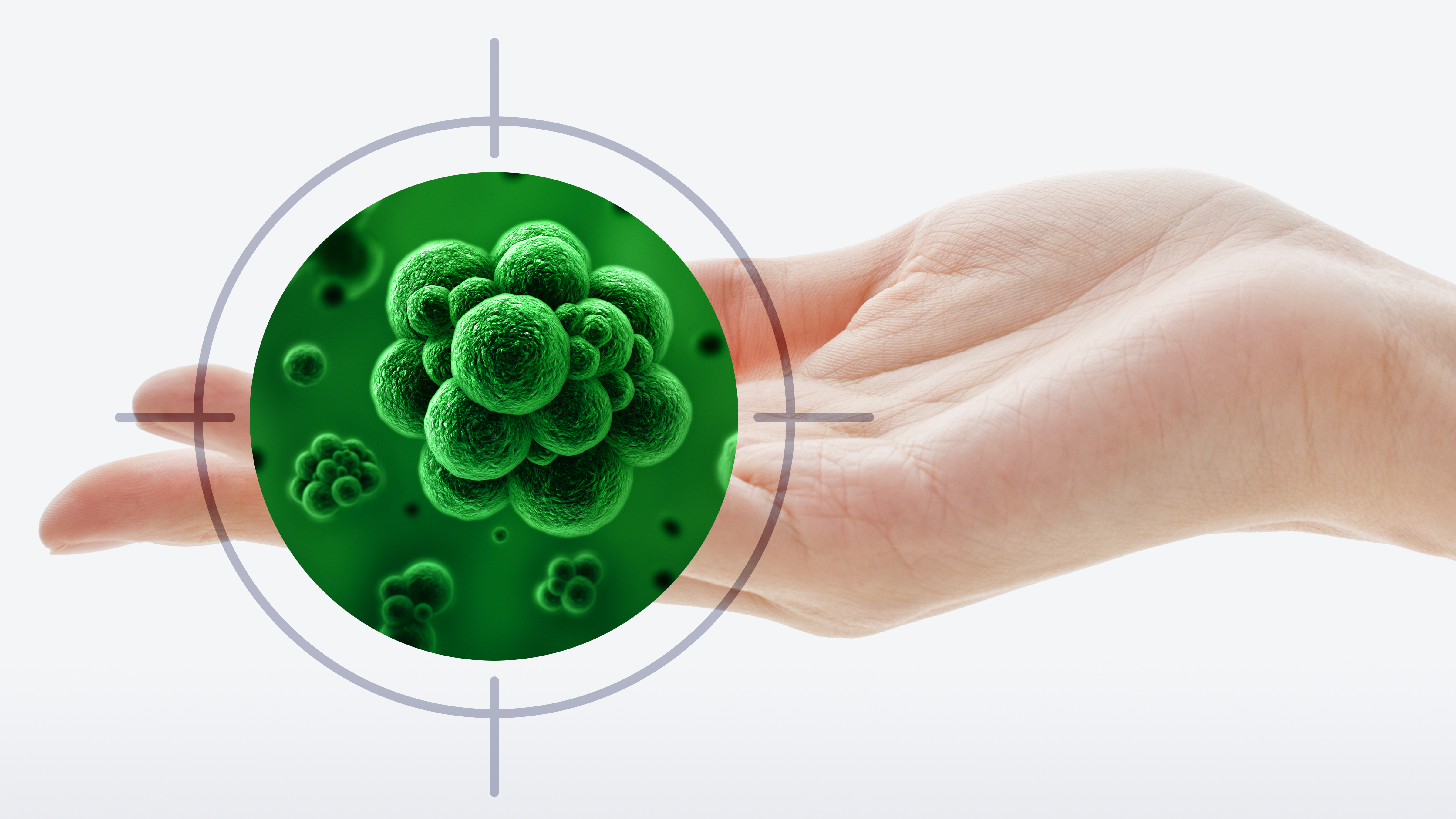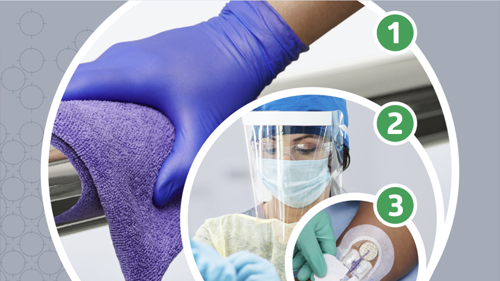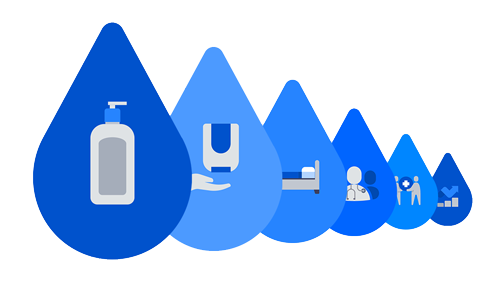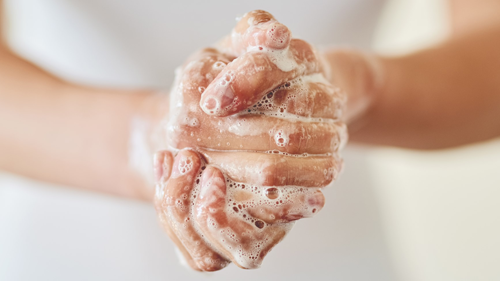Why is hand hygiene the first line of defense against HAIs?
Proof of how hand washing prevents the spread of pathogens spans centuries.

On any given day, about one in 31 hospital patients in the US has at least one healthcare-associated infection (HAI).1 Hand hygiene reduces the incidence of HAIs—it’s the simplest and most important factor in preventing the spread of pathogens and antibiotic resistance in healthcare settings. So why is caregiver hand hygiene compliance from 40 to 50%?2 The “perception that excessive hand cleaning is required and that wearing gloves negates the need for hand hygiene” are among the self-reported barriers.3
Scientific studies and trials provide proof
Let’s examine the science behind clean hands, starting in Europe nearly two centuries ago. In April 1847, Ignaz Philipp Semmelweis, a Hungarian physician, was working in Vienna General Hospital’s First Obstetrical Clinic. This clinic was used for teaching medical students who conducted autopsies as part of their training, while a second clinic was used only for the training of midwives who had no contact with cadavers. Semmelweis noted that the mortality rate from puerperal or “childbed” fever was 18.3% when the physicians attended obstetrical patients directly after performing autopsies. The rates were much lower in the second clinic.
He proposed the practice of washing hands in a solution of chlorinated lime (calcium hypochlorite) as a way to “remove the putrid smell of infected autopsy tissue.” After the hand cleaning practice was put in place in May, the rates dropped 90% to 2.2%, 1.2% and 1.9%, respectively, in June, July and August, comparable to the second clinic.
While today Semmelweis is known as the grandfather of hand hygiene, his research was at odds with the prevailing opinions of scientists and physicians at the time. His recommendations were rejected by the medical community at large, with some doctors taking offense at the suggestion that they should wash their hands. They ridiculed Semmelweis, who in 1865 experienced a nervous breakdown. His colleagues committed him to an asylum where, after a beating by guards, he died from an infection.4
In the 1840s, some doctors took offense at Semmelweis’ suggestion that they should wash their hands.
Yet studies continued. In the 1960s, a prospective, controlled trial sponsored by the National Institutes of Health and the Office of the Surgeon General demonstrated that infants cared for by nurses who did not wash their hands after handling an index infant colonized with S. aureus acquired the organism more often and more rapidly than did infants cared for by nurses who used hexachlorophene to clean their hands between infant contacts. This trial provided evidence that, when compared with no handwashing, washing hands with an antiseptic agent between patient contacts reduces transmission of healthcare-associated pathogens.5
Seven quasi-experimental hospital-based studies of the effect of hand hygiene on the risk of nosocomial infection were published between 1977 and 1995. In one of these, endemic MRSA was eliminated in 7 months in a neonatal intensive care unit following the introduction of a new hand disinfectant.
Another study reported a MRSA outbreak involving 22 infants in a neonatal unit, which could not be controlled despite intensive and comprehensive measures until another disinfectant was widely introduced.6
A breakthrough in the 1980s
It wasn’t until the 1980s—a century after the success of Semmelweis—that the concept of hand hygiene in healthcare evolved. The first national hand hygiene guidelines were published in the 1980s, followed by several others in more recent years in different countries. In 1995 and 1996, the US Centers for Disease Control and Prevention (CDC)/Healthcare Infection Control Practices Advisory Committee (HICPAC) recommended that either antimicrobial soap or a waterless antiseptic agent be used for cleansing hands upon leaving the rooms of patients with multidrug-resistant organisms (MDROs).5
Another watershed moment occurred in 2002 when the CDC released new hand hygiene guidelines that advised the use of alcohol-based handrubs with 60 to 90% alcohol to protect patients in healthcare settings.7
How hand pathogens spread
Science has proved that clean hands reduce the spread of HAIs. How do dirty hands increase the spread? When the following sequence of events occurs, healthcare-associated pathogens are transmitted from one patient to another via the hands of caregivers:
- Organisms on the patient’s skin, or that have been shed onto inanimate objects near the patient, are transferred to the hands of caregivers.
- These organisms are capable of surviving for at least several minutes on the hands of personnel.
- Next, handwashing or hand antisepsis by the caregiver is inadequate or omitted entirely, or the agent used for hand hygiene is inappropriate.
- Finally, the contaminated hands of the caregiver come in direct contact with another patient, or with an inanimate object that will come into direct contact with the patient.
Healthcare-associated pathogens can be recovered not only from infected or draining wounds, but also from frequently colonized areas of normal, intact patient skin. For example, caregivers can contaminate their hands with C. difficile by performing “clean procedures” or touching intact areas of the skin of hospitalized patients.7
Caregivers will take appropriate precautions when they know a patient has an infectious disease like TB, but in general, they seem to think there’s a low risk of catching a disease from a patient.

Angela Zuick
Medline Director of Clinical Services
Patients/residents aren’t the only ones at risk
Caregivers can also become infected during patient care. During the Marburg viral hemorrhagic fever event in Angola, transmission within healthcare settings played a major role in the amplification of the outbreak (WHO unpublished data). Nosocomial clustering, with transmission to caregivers, was a prominent feature of severe acute respiratory syndrome (SARS). Similarly, caregivers were infected during the influenza pandemics and have been infected during the COVID-19 pandemic.
Transmission occurs mostly via large droplets, direct contact with infectious material or through contact with inanimate objects contaminated by infectious material. Performance of high-risk patient care procedures and inadequate infection control practices contribute to the risk. Transmission of other viral and bacterial illnesses including tuberculosis to caregivers is also well known.5
Alcohol-based handrubs are the most effective means of reducing the number of bacteria on caregivers’ hands.7
Why skin microorganism type matters
The skin harbors mainly two types of microorganisms: the resident and the transient (contaminant) flora.
- Resident flora has a low pathogenic potential unless introduced into the body by invasive devices. It’s difficult to remove by mechanical means.
- Transient flora has a short-term survival rate on the skin but has a high pathogenic potential. It’s responsible for most nosocomially acquired infections resulting from cross-transmission.
The aim of hand hygiene is to decrease hand colonization with transient flora. The ideal technique should be quick to perform, reduce hand contamination to the lowest possible level and be free from significant side-effects on the skin.7
Use products with the right ingredients
That brings us to another hand hygiene barrier: skin irritation and dryness. When evaluating hand hygiene products for potential use in healthcare facilities, purchasers should consider the relative efficacy of antiseptic agents against various pathogens and the acceptability of hand hygiene products by personnel. Product acceptance can be affected by characteristics of the product such as its smell, consistency, color and the effect of skin irritation and dryness on hands. Easy access to hand hygiene supplies at or near the point of care is essential for acceptance and use of products.
Alcohol-based handrubs (hand sanitizers) provide several advantages compared with handwashing with soap and water:
- Require less time
- Require no water or towels
- Provide easy access at or close to the point of care
- Act faster
- Are more effective for routine hand hygiene when hands are not visibly soiled
- Can be formulated with emollients/moisturizers to help drive compliance while improving skin condition and keeping resident skin flora intact
And alcohol-based handrubs are the most effective means of reducing the number of bacteria on caregivers’ hands.7
The benefits outweigh the costs
Healthcare facilities should consider comparing their budget for hand hygiene products with estimated excess hospital costs resulting from HAIs. The costs associated with only four or five HAIs of average severity may equal the entire annual budget for hand hygiene products used in inpatient care areas. Just one severe surgical site infection, MRSA case or bloodstream infection may cost the hospital more than the entire annual budget for antiseptic agents used for hand hygiene.7
Key takeaway
High-frequency hand hygiene is the easiest and best way to reduce HAIs. Centuries of studies have proved its effectiveness. Well-formulated alcohol-based hand sanitizers with moisturizers are the best choice for driving compliance and reduced risk for patients/residents, family members, visitors and staff.
References:
- CDC. Hand Hygiene in Healthcare Settings. Accessed February 4, 2022. Available at: Hand Hygiene in Healthcare Settings | CDC.
- CDC. Hand hygiene in healthcare settings core presentation. 2002. Available at: https://www.cdc.gov/HandHygiene/download/hand_hygiene_core.pdf
- What causes hand hygiene noncompliance? 24 issues. Becker’s Clinical Leadership & Infection Control. January 7, 2015. Available at: https://www.beckershospitalreview.com/quality/what-causes-hand-hygiene-noncompliance-24-issues.html
- Alper, Paul. Major historical milestones in healthcare hand hygiene. Healthcare Hygiene Magazine. August 2021. Available at: https://www.healthcarehygienemagazine.com/august-2021-issue-of-healthcare-hygiene-magazine-is-now-available/
- WHO Guidelines on Hand Hygiene in Healthcare: A Summary. 2009. Available at: https://www.who.int/gpsc/5may/tools/who_guidelines-handhygiene_summary.pdf
- Hand hygiene—beliefs or science? Hugonnet, S., and D. Pittet. ClinMicrobiol Infect 2000: 6: 348-354. Available at: https://www.sciencedirect.com/science/article/pii/S1198743X14649776
- CDC. Guideline for hand hygiene in health-care settings. October 25, 2002/Vol. 51 / No. RR-16. Available at: https://www.cdc.gov/mmwr/PDF/rr/rr5116.pdf




